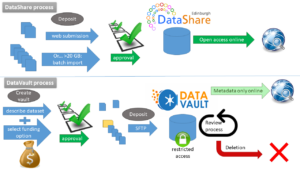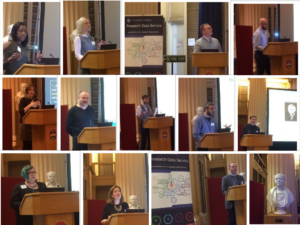Two members of the Research Data Support team recently had an adventure visiting Japan in order to provide practical lessons to library students and librarians studying in a research data management (RDM) course.
When Professor Emi Ishita had visited the team in 2023, she was preparing a new syllabus for research data management for her library students at the Kyushu University iSchool. Struck by the strong engagement our team members had with researchers through training, supporting data management plans, and moderating data deposits, she returned in August, 2024 with a delegation of practicing librarians to learn from the Universities of Edinburgh, Leeds, and Oxford. The group spent a full day with various members of Library Research Support, going over a question list they had sent in advance, about Open Access (OA) and RDM support, and our approach to training researchers.
At the end of the session, Emi revealed that a grant was available to pay for two RDM practitioners from UoE to come to Kyushu University in Fukuoka to contribute to an October, 2024 public symposium and a two day-long in-person training sessions for her students. The students would include Masters students enrolled in the iSchool at Kyushu, as well as practicing librarians looking to reskill themselves following government policy directives embracing immediate open access and data sharing for research publications.
 The speakers for the hybrid symposium on OA and RDM in Japan were myself with Dr Simon Smith, along with long-time RDM service provider Jake Carlson from the University of Buffalo (New York), and the Library Director from Chiba University, and the Research Data Service Director at Kyushu University providing a Japanese context for OA and RDM. Dr Ishita introduced the symposium and chaired the panel session – her team also provided all the speakers with beautifully presented bento boxes tailored to each person’s diet for lunch.
The speakers for the hybrid symposium on OA and RDM in Japan were myself with Dr Simon Smith, along with long-time RDM service provider Jake Carlson from the University of Buffalo (New York), and the Library Director from Chiba University, and the Research Data Service Director at Kyushu University providing a Japanese context for OA and RDM. Dr Ishita introduced the symposium and chaired the panel session – her team also provided all the speakers with beautifully presented bento boxes tailored to each person’s diet for lunch.
While the symposium was exciting, with about 60 people in attendance and about 130 more watching and listening online, it was the practical training that myself and Simon found truly inspirational. The students overcame their customary reserve to answer Simon’s open-ended questions about supporting researchers with data management planning in a classroom setting. Later, they formed into small groups to try out depositing data in DataShare, and evaluate each other’s metadata for quality. The technology worked, the students were curious and engaged, and the Kyushu instructors were pleased with the outcome.

 During the week of the event, Simon and I visited prior and new contacts at Tokyo University, Chiba University, Kyoto University, Nagoya University and NII. In addition to the excellent company, we were pleased to be visiting such a beautiful country and eating the wonderful food.
During the week of the event, Simon and I visited prior and new contacts at Tokyo University, Chiba University, Kyoto University, Nagoya University and NII. In addition to the excellent company, we were pleased to be visiting such a beautiful country and eating the wonderful food.






